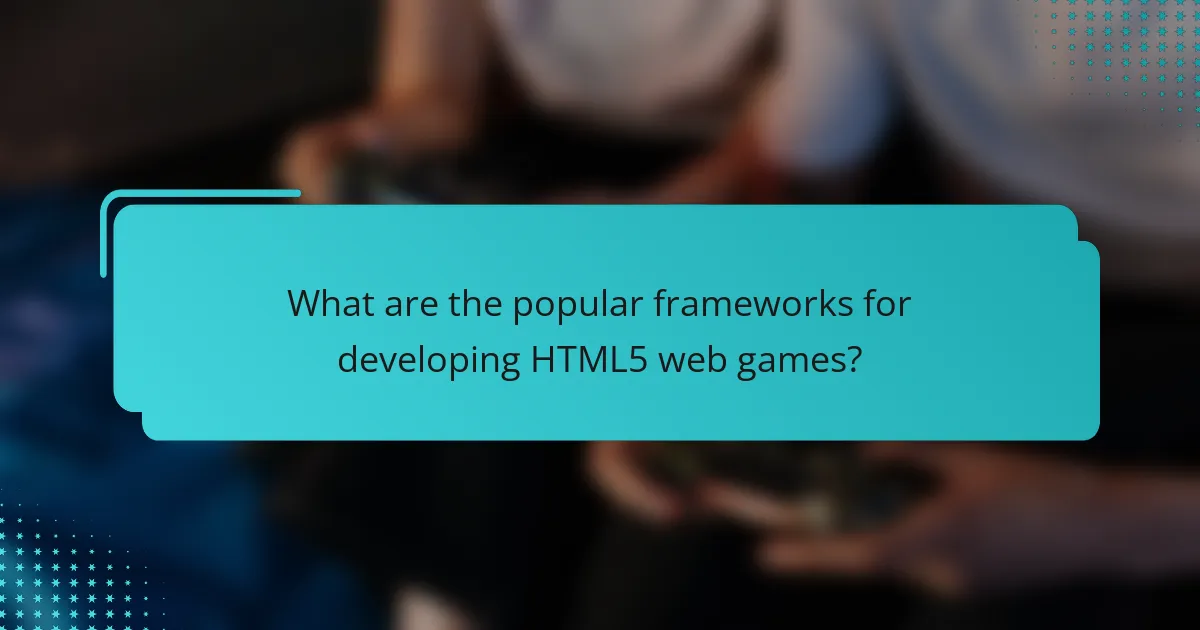
What is HTML5 and why is it important for web games?
HTML5 is the fifth version of the Hypertext Markup Language, used for structuring content on the web. It introduces new features such as native support for audio and video, improved graphics through the Canvas element, and enhanced capabilities for creating interactive applications. HTML5 is important for web games because it allows developers to create rich, engaging experiences without relying on plugins like Flash. This leads to better performance and compatibility across various devices and browsers. Additionally, HTML5 enables the use of JavaScript for game logic, which allows for more dynamic and responsive gameplay. Statistics show that over 70% of web games now utilize HTML5, highlighting its dominance in the gaming industry.
How does HTML5 differ from previous versions in game development?
HTML5 differs from previous versions in game development by providing native support for audio and video playback. This allows developers to create rich multimedia experiences without relying on third-party plugins. Additionally, HTML5 introduces the Canvas element, enabling dynamic, scriptable rendering of 2D shapes and bitmap images. This capability enhances graphics performance and flexibility in game design. Furthermore, HTML5 supports WebGL, which allows for hardware-accelerated 3D graphics in the browser. This feature significantly improves the visual quality of games compared to earlier HTML versions. HTML5 also includes improved storage options through local storage and IndexedDB, facilitating better data management for games. Lastly, HTML5 is designed for cross-platform compatibility, allowing games to run seamlessly on various devices and operating systems.
What are the key features of HTML5 that enhance gaming experiences?
HTML5 enhances gaming experiences through several key features. Firstly, the Canvas API allows for dynamic, high-performance graphics rendering. This enables developers to create visually rich gaming environments. Secondly, WebGL provides hardware-accelerated 3D graphics. This technology is crucial for immersive gaming experiences. Thirdly, the Audio API supports advanced audio features. It allows for spatial sound and sound effects that enhance gameplay. Additionally, HTML5 supports local storage for saving game states. This feature improves user experience by allowing players to resume their games seamlessly. Lastly, HTML5 is inherently cross-platform. Games built with HTML5 can run on various devices without modification. These features collectively contribute to a more engaging and versatile gaming experience.
How does HTML5 support multimedia and graphics in games?
HTML5 supports multimedia and graphics in games through various built-in features. It provides the
What are the advantages of using HTML5 for web game development?
HTML5 offers several advantages for web game development. It provides cross-platform compatibility, allowing games to run on various devices and operating systems without modification. HTML5 supports advanced graphics through the Canvas element and WebGL, enhancing visual quality. It also includes built-in audio support, facilitating sound integration in games. The language is lightweight, resulting in faster load times and improved performance. Additionally, HTML5 enables easy access to device features, such as touch controls and geolocation. The extensive community and library support accelerate development, providing developers with numerous resources. These factors contribute to HTML5’s growing popularity in the gaming industry.
How does HTML5 improve cross-platform compatibility for games?
HTML5 improves cross-platform compatibility for games by providing a unified framework that works across different devices and operating systems. It eliminates the need for separate codebases for various platforms. HTML5 games run in web browsers, making them accessible on desktops, tablets, and smartphones. This universality means developers can reach a wider audience without extensive modifications. The use of standard web technologies like JavaScript, CSS, and HTML allows for consistent performance. According to a report by Statista, over 90% of internet users access the web through browsers, highlighting the significance of cross-platform accessibility. Additionally, HTML5 supports responsive design, enabling games to adapt to various screen sizes seamlessly. This adaptability further enhances the user experience across devices.
What performance benefits does HTML5 offer for game developers?
HTML5 offers significant performance benefits for game developers. It enables hardware acceleration through the use of the Canvas API and WebGL. This allows for smoother graphics and improved rendering speed. HTML5 also supports asynchronous loading of game assets, reducing load times. Additionally, it provides cross-platform compatibility, allowing games to run on various devices without performance loss. The use of JavaScript in HTML5 enhances interactivity and responsiveness. Furthermore, HTML5 games can leverage the capabilities of modern web browsers, optimizing performance further. These features collectively enhance the gaming experience for users.

What are the popular frameworks for developing HTML5 web games?
Popular frameworks for developing HTML5 web games include Phaser, Construct, and Three.js. Phaser is a robust framework that supports 2D game development. It offers features like physics, input handling, and animations. Construct is a user-friendly, drag-and-drop engine ideal for beginners. It allows for rapid game prototyping without extensive coding skills. Three.js is a powerful library for creating 3D graphics in the browser. It leverages WebGL for rendering complex visuals. Each framework has its unique strengths, catering to different types of game developers.
Which HTML5 game development frameworks are widely used?
Phaser, Construct, and Three.js are widely used HTML5 game development frameworks. Phaser is known for its robust 2D game development capabilities. It supports WebGL and Canvas rendering. Construct is a powerful drag-and-drop game maker. It allows developers to create games without extensive coding knowledge. Three.js excels in 3D graphics and is widely adopted for 3D web games. These frameworks are popular due to their extensive documentation and active community support.
What are the unique features of each popular framework?
Unity offers a comprehensive game development environment with robust 2D and 3D capabilities. It supports multiple platforms, ensuring cross-platform compatibility. Unreal Engine is known for its high-fidelity graphics and visual scripting through Blueprints. It is ideal for creating visually stunning games. Phaser is a lightweight framework focused on 2D game development. It provides a simple API and is easy to learn for beginners. Three.js specializes in 3D graphics using WebGL, allowing developers to create immersive 3D experiences in the browser. Construct is a no-code framework that enables rapid game development through a drag-and-drop interface. Each framework has distinct features tailored to different types of game development needs.
How do these frameworks support different types of games?
HTML5 frameworks support different types of games by providing versatile tools and libraries tailored for various genres. Frameworks like Phaser and Three.js enable 2D and 3D game development respectively. They offer built-in features such as physics engines, rendering capabilities, and asset management. These features streamline the development process for platformers, puzzle games, and simulations. Additionally, frameworks often include community support and documentation, aiding developers in troubleshooting and enhancing their games. For instance, Phaser is widely used for 2D games, while Three.js excels in creating immersive 3D experiences. This adaptability makes HTML5 frameworks suitable for a broad spectrum of gaming styles.
What should developers consider when choosing a framework?
Developers should consider compatibility, performance, community support, and learning curve when choosing a framework. Compatibility ensures the framework works across different browsers and devices. Performance affects game speed and responsiveness, impacting user experience. Community support provides access to resources, help, and updates. A lower learning curve can accelerate development time. Frameworks like Phaser and Three.js are popular for HTML5 game development due to their strong community and performance capabilities.
How does project scope influence framework selection?
Project scope significantly influences framework selection by determining the project’s complexity and requirements. A broader scope typically necessitates a more robust framework to accommodate various features. For example, larger projects may require frameworks that support advanced graphics and multiplayer functionality. Conversely, a narrower scope might allow for simpler frameworks that are easier to implement. Additionally, the project timeline can affect framework choice; tight deadlines may favor frameworks with faster development capabilities. Ultimately, aligning the framework with the project scope ensures that technical requirements are met efficiently.
What are the community support and resources available for each framework?
The community support and resources available for each HTML5 game development framework vary. Popular frameworks such as Phaser, Three.js, and Babylon.js offer extensive documentation. Phaser has a vibrant community forum and numerous tutorials. Three.js provides an active GitHub repository with examples and discussions. Babylon.js features a dedicated playground for real-time code testing. Each framework also hosts community-driven resources like blogs, YouTube channels, and Discord servers. These resources facilitate collaboration and knowledge sharing among developers.

What are some essential development tips for HTML5 web games?
Use a game engine like Phaser or Construct for streamlined development. These engines provide built-in features for game mechanics and graphics. Optimize graphics to ensure fast loading times and smooth performance. Use spritesheets to reduce the number of image requests. Implement responsive design to ensure compatibility across various devices. Test games on multiple browsers to identify performance issues. Utilize HTML5 local storage for saving game progress. Regularly update your code to maintain compatibility with new web standards. These practices enhance user experience and game performance.
How can developers optimize performance in HTML5 games?
Developers can optimize performance in HTML5 games by minimizing resource usage. They should reduce the size of assets like images and sounds. Using compressed formats can significantly decrease loading times. Implementing efficient coding practices is crucial. This includes avoiding memory leaks and using object pooling. Developers should also leverage hardware acceleration when possible. Utilizing the requestAnimationFrame method can improve rendering performance. Profiling tools can identify bottlenecks in the code. These practices lead to smoother gameplay and better user experiences.
What techniques can be used to reduce load times in games?
Techniques to reduce load times in games include asset optimization, lazy loading, and efficient data management. Asset optimization involves compressing textures and audio files to reduce their size. This can lead to faster loading as smaller files take less time to transfer. Lazy loading allows assets to be loaded only when needed, rather than all at once. This technique improves initial load times significantly. Efficient data management, such as using data streaming, can also reduce load times by loading only necessary data at the start. Additionally, minimizing HTTP requests by combining files can enhance loading speed. These methods collectively contribute to a smoother gaming experience.
How can developers ensure smooth gameplay on various devices?
Developers can ensure smooth gameplay on various devices by optimizing game performance. This includes reducing asset sizes to enhance load times. They should also implement adaptive resolution techniques for different screen sizes. Utilizing efficient coding practices helps minimize lag and improve responsiveness. Developers can test games on multiple devices to identify performance issues. They should monitor frame rates to ensure consistent gameplay. Implementing a robust physics engine can also enhance performance across devices. Additionally, using HTML5 features like WebGL can improve graphics rendering efficiency.
What common pitfalls should developers avoid in HTML5 game development?
Developers should avoid several common pitfalls in HTML5 game development. One major issue is neglecting performance optimization. Poor performance can lead to lag and a frustrating user experience. Another pitfall is failing to test across multiple browsers. Different browsers can render HTML5 games inconsistently. Developers often overlook mobile compatibility. Many users access games on mobile devices, making this crucial. Additionally, not managing memory effectively can cause crashes. Games that consume too much memory may not run smoothly. Lastly, ignoring user feedback can hinder improvement. Developers should prioritize user experience to enhance gameplay.
How can developers effectively debug HTML5 games?
Developers can effectively debug HTML5 games by utilizing browser developer tools. These tools allow for real-time inspection of HTML, CSS, and JavaScript. They provide features such as breakpoints, which enable developers to pause code execution and inspect variables. Console logging is also essential for tracking errors and monitoring game state.
Additionally, using performance profiling tools helps identify bottlenecks in rendering and script execution. Tools like Chrome DevTools offer a timeline view to analyze frame rates and resource usage. Testing on multiple browsers ensures compatibility and uncovers browser-specific issues.
Finally, leveraging community resources, such as forums and documentation, can provide solutions to common debugging challenges. These practices collectively enhance the debugging process, leading to a smoother gaming experience.
What are the best practices for maintaining code quality in game projects?
Best practices for maintaining code quality in game projects include implementing version control, conducting regular code reviews, and adhering to coding standards. Version control systems, like Git, help track changes and facilitate collaboration among developers. Regular code reviews ensure that multiple eyes examine the code, catching potential issues early. Adhering to coding standards promotes consistency and readability, making it easier for team members to understand each other’s work. Automated testing is also crucial; it helps identify bugs before they reach production. Utilizing code analysis tools can further enhance code quality by detecting vulnerabilities and enforcing best practices. These strategies collectively contribute to a more maintainable and robust codebase in game development.
What resources are available for improving HTML5 game development skills?
Online tutorials and courses are available for improving HTML5 game development skills. Platforms like Udemy and Coursera offer structured learning paths. Free resources include Mozilla Developer Network (MDN) and W3Schools, which provide documentation and examples. Books such as “HTML5 Game Development by Example” offer practical insights. Game development communities on forums like Stack Overflow can provide support and advice. YouTube channels dedicated to game development feature tutorials and project walkthroughs. Additionally, GitHub hosts numerous open-source HTML5 game projects for hands-on learning. These resources collectively enhance understanding and practical skills in HTML5 game development.
HTML5 is the primary entity discussed, highlighting its significance in web game development. The article covers the advantages of HTML5, including cross-platform compatibility, enhanced graphics, and built-in multimedia support, which collectively improve gaming experiences. It also reviews popular frameworks like Phaser, Construct, and Three.js, detailing their unique features and suitability for different game types. Additionally, essential development tips and best practices for optimizing performance, debugging, and maintaining code quality are provided to support developers in creating engaging HTML5 web games.